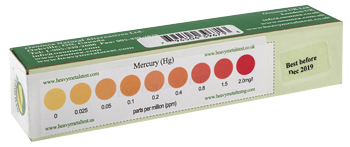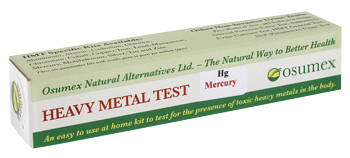|
| Water Test Kit (2-test pack) |
| Adrenal Function Urine Test |
| Sulkowitch Urine (Calcium) Test |
|
|
|
HMT MERCURY TEST KIT
Number 80 on the "periodic table" of elements
Preparation of Test Solutions
Note: In order to test saliva accurately, add 2ml of weak (10%) acetic acid to 8ml of saliva collected from chewing sugarless gum that is not flavoured. Then
bring to boil and filter. Adjust the pH to between 3 - 5 with weak (10%) sodium hydroxide (NaOH). The saliva is now ready for testing.
- Remove the the 3 small plastic ampoules from the large test tube
- In the empty large test-tube, add 6 ml. of the solution to be tested
- Add the colourless liquid from the blue cap vial (reagent 2) to the solution to be tested in the large test tube ("combined solutions").
Turn the test large test tube gently up and down a few times (at least 3) to make sure that the 2 liquids are well mixed together
- Add the colourless liquid from the clear cap vial (reagent 1) to the vial containing the reddish brown substance (reagent 3). Close the cap of the red cap vial and
shake until the reddish-brown substance has been mostly dissolved ("mixed solution"). This may take a little while
- The solutions are now ready for testing
Conducting the test
- Pour the "mixed solutions" (reagents 1 and 3) in the vial with the reddish brown substance into the large test-tube
containing the "combined solutions" (reagent 2 and solution to be tested)
- Allow combined solutions in the large test-tube to settle for 6 minutes - shaking is usually not required but if there is no chemical reaction or colour change,
tilt the test tube or "roll" it gently a few times to make sure the solutions are mixed well to obtain a true and accurate colour change
- Compare the colour of the combined solutions in the large test-tube to the colour strip provided. In case of
comparison difficulties, try holding the test-tube against the colour strip just above liquid level of large test-tube. Move
along the colour strip until colour of solution matches with that of the colour strip
- The number on the colour strip indicates the concentration of mercury ions present in the solution in ppm
- If the concentration of the mercury ions is higher than 2 ppm the solution will change into a strong pink colour after a period of time
- If the concentration is extremely low or no mercury ions are present, the colour of the solution will clear and become almost
colourless after a period of time. However, if saliva is tested and there are strong digestive enzymes present, they may affect anc cause a different final colour
(such as green)
Test Interference:
The test results can be affected by the presence of ions from gold, silver, palladium, rhodium, platinum,
iridium, ruthenium ("noble metals") as well as tin.
Colour strip

The numbers indicate concentration in ppm
Accuracy of the test
Reputable establishments such as schools and universities are using the mercury kit in their establishments. This attest to the accuracy and
acceptability of the kit. Listing of such establishments and articles where the kit was used follows:
- University of California, Santa Barbara, CA USA - used in various experiments to develop science cirriculum for state schools;
- Kent State University, OH USA - PhD. student used mercury kit in PhD thesis project - read his statement:
"Yes, I used them in my analyses of urine and fecal samples of wild primates. It took several weeks of tweaking my
experiment in a lab here in the U.S. but I finally figured a relatively reliable method (since Hg measurement in feces was a small problem).
In the end the kits worked great, granted sometimes the fecal measurements did not always show up. This is largely in part due to specific
digestive mechanisms of some species of primates. A couple of samples turned green, which I think indicate the presence of digestive enzymes."
View his paper - click here
 
Sample of a HMT Mercury Test kit with color strip for results analysis

The above information is provided for general
educational purposes only. It is not intended to replace competent
health care advice received from a knowledgeable healthcare professional.
You are urged to seek healthcare advice for the treatment of any
illness or disease.
Health Canada and the FDA (USA) have not evaluated these
statements. This product is not intended to diagnose, treat, cure, or prevent
any disease.
|


